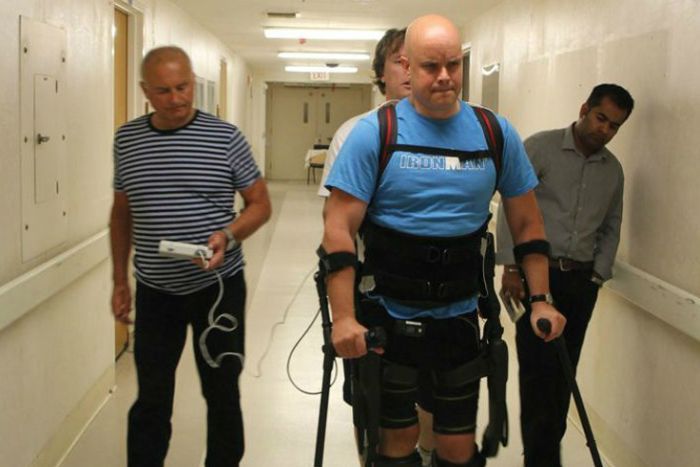
Despite a complete cut, nerves below a lesion retain a memory of moves and functions they once controlled. Reggie Edgerton worked with Christopher Reeve following the equestrian accident which left him a with quadriplegia. Professor Edgerton helps patients relearn movement and functions following spinal cord injury. He says if the nerve circuitry can be reengaged, then it can relearn its control of how to walk, how to stand and the things it normally does. Rather than sit or lie in bed after an accident, patients need to stimulate their nerves, gradually increasing stimulatory information.
Transcript
Robyn Williams: In 1995, Superman (Christopher Reeve) fell off his horse and became paralysed, a quadriplegic. He was even intubated with a breathing tube in his throat. But he went to UCLA to see the scientists like Reggie Edgerton who perhaps could help him walk again.
Reggie Edgerton: Yes, we worked with him for some time. He was very interested in our work related to locomotor training.
Robyn Williams: You must have taught him well because his knowledge of brains, of nervous systems and stem cells when he came to lecture in Sydney was formidable.
Reggie Edgerton: He was very impressive from that standpoint. And it only took me about five minutes to realise how impressive he was. I guess I and maybe others tend to think, well, he's just an actor, but it became evident quite quickly that he was just focused on understanding everything he possibly could. He was a very clever individual.
Robyn Williams: Did you help him in those experiments trying to make him walk?
Reggie Edgerton: We tried. We had never had an individual who was intubated for respiration on the treadmill, and haven't since then actually. And he is a very large individual, and so Dr Harkema who was the principal one in the lab that was working on the technique at the time, she was very anxious about how this was going to go. And the other thing is, once you get them up, their cardiovascular responses are not normal and they tend to get faint, and so the first problem was getting him up. He was so large, tall, he was bigger than what our equipment was well adjusted for. But anyway, we finally got that figured out, got him up, and in the process of doing all this adjustment he started getting faint. And so we had to let him down real quick. So we thought, well, maybe that would be the end of it. And then after he sat down for a few minutes and he was okay and we said, 'You want to try it again?' He didn't hesitate, he was ready to go again.
Robyn Williams: The Science Show, today with babies, language and helping paraplegics to move again. Professor Reg Egerton and the team at UCLA have helped a 39-year-old man, paralysed for four years, to take steps, using an exoskeleton. They also use spinal stimulation to re-educate the lower part of the cord.
What is the theoretical basis of your attempts to reactivate cut nervous systems?
Reggie Edgerton: We found out some years ago that the spinal cord circuitry can learn. What’s referred to as a complete spinal cord injury, that means no information can get down or up across that lesion, but people don't realise that that circuitry below the lesion is pretty much intact. It has forgotten a lot of stuff but it's still there. And so the bottom line is, if we can figure out a way to reengage the circuitry, then it can relearn how to walk and to stand and do the things that it would normally do.
The problem is with this spinal cord sitting there and not having its normal input from proprioception and cutaneous information, it's forgotten basically how to perform these normal movements, plus the fact it doesn't have a chance to do these because it never gets the sensory information that is associated with load bearing and movement. The person is in a chair or in bed, so there is very little of that normal sensory information. But if you can arrange things so that you can return those sensations, then the spinal cord can begin to regain function.
You've heard of muscle sense, well there is amazing detail, sensory input from muscles and tendons and skin that is coming back to the spinal cord. But if you never have a person load-bearing or the person is not stepping in an alternating pattern, then all of that disappears. But we know now that if we can reengage the circuitry…and we've found out that in human subjects, as we did in animal subjects, that we can stimulate in a certain way so that the spinal cord can now hear what's going on in the muscles and tendons and skin. In essence it remembers what it always knew, but now this new information is coming back and it's modifying the circuitry so now it can start to perform these movements.
So when you put them on the treadmill with partial weight bearing, and just the beginning you gradually and progressively begin to increase that sensory information, that highly coordinated way, the way it always has been. And now the circuits in the spinal cord say, well okay, I recognise this, and it knows what to do and it makes a decision to perform, even though that information is not going to the brain.
Robyn Williams: Isn't that interesting! You've done it with a human being who's got paralysed legs. What happened when you tried to help him walk?
Reggie Edgerton: Well, they assist in the stepping. We have not been able to get anyone with a complete spinal cord injury to walk completely independent yet. We can get them to stand and balance to some degree, and they have other physiological changes, like in the cardiovascular system, the blood pressure improves, there is improvement in bladder function. Some subjects have seen improved sexual function, temperature control. Once you get the motor system going, these other systems somehow start to come in and get reintegrated into your nervous system. We function as an organism, we don't function as cardiovascular and then there's respiratory and then there's muscle, those systems are highly integrated. So it seems like the system just wants to reintegrate all these systems, so that's why we think we are seeing so many of these things. But we still haven't quite got all the details that we need in order to get someone walking completely independently.
Robyn Williams: But you got close, and you used an exoskeleton, in other words the stiff cladding on the outside.
Reggie Edgerton: We are getting close. We think we are going to get there, and maybe not too far in the future. But when we went into this with stimulation of the spinal cord, we knew the technology was probably not going to be good enough because we were using an off-the-shelf technology designed for pain suppression. So this epidural electrode is implanted kind of routinely in the spinal cord injury subjects, that have pain, so we use the present technology, even though it's a device that is not as smart as what we need, and we knew that from our animal experiments, but that has gotten us to the point where we were able to accomplished a lot of stuff beyond what we had anticipated with the standing.
But the other interesting thing that has happened is when the individuals regain voluntary control, so it's not just automatically determined by proprioception and cutaneous information going to the spinal cord, now we've been able to get the brain and the spinal cord to communicate. This is what has shocked everyone, including us, because we didn't anticipate this, but we are finding it in virtually every subject that we've studied so far that has been diagnosed clinically as having a complete injury. The brain has learned how to reach the spinal cord. Now we need to get the two working together.
The first individual that was implanted with epidural electrodes seven years ago is still improving. So the dogma is, after a spinal cord injury you will get some spontaneous recovery in the first six months to 12 months. After 12 months, nothing. You don't expect anything. So the patient, insurance companies, the family, no one expects anything to happen at that point. That's just the dogma, everybody has accepted that. That is completely false, completely false. Every one of our subjects that we have studied have been beyond a year. Some of them up to 21 years. And so now it's a new situation because we know this activity dependent plasticity can persist for a long time.
Robyn Williams: And what sort of faculties can be reawakened, in your experience, now?
Reggie Edgerton: So far the first thing that is highly significant is for a person to be able to stand independently. That is really a big deal. Once you can start to weight bear, that's when a lot of these other physiological systems start to occur.
But then the other thing is we said, well, can this happen if we stimulate the cervical region of the spinal cord as opposed to the lumbar region which controls the legs. So the experiments which stimulated the cervical region are really showing just as dramatic changes, grip strength for example. Other functions are coming into play that are highly significant for the individuals. Because if you have individuals completely dependent on a caregiver to eat, to do everything, a little bit of improvement in a motor function can make a huge difference. And so we've gotten some evidence, for example, that we think it's going to be possible for a person that can't feed themselves, we can get them to feed themselves.
Robyn Williams: Isn't that extraordinary. You're coming to the University of Technology in Sydney to do some work with them as well. What is that going to be all about?
Reggie Edgerton: Well, we are going to try to develop a core facility that will be a combination of experts in physiology, but it's going to be done in a technological environment. These findings are so new and in many ways unexpected, that it has told us that we are not even close to the limit. But the technical potential I would say is 20 years ahead of our clinical ability to take advantage of the technology. So we've got to get them matched. The injured nervous system can do much more than what we anticipated. So now how can we develop technology that is going to help us to get to the next stage? And that's why I always say we are at the Model T stage at this right now, Model T Ford stage, and we want to get to the Tesla, so…but that's going to take some time.
Robyn Williams: But moving fast. Reggie Edgerton is a distinguished professor of physiology and neurosurgery at the University of California, Los Angeles.
Guests
Reggie Edgerton
Professor, Department of Integrative Biology and Physiology
Brain Research Institute
University of California
Los Angeles CA USA
Further Information
NDIS THERAPY FINDER - FREE SERVICE
LET US FIND YOU A SKILLED SUPPORT WORKER

